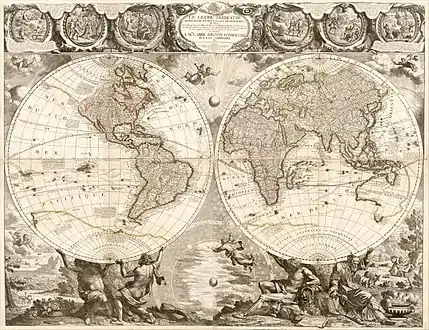Jean-Baptiste Nolin (c. 1657–1708) was a French cartographer and engraver.
Life and career
Jean-Baptiste Nolin was born c. 1657.[1] He trained with the engraver François de Poilly, which caught the attention of the Italian cartographer Vincenzo Coronelli, who invited him to engrave his own maps.[2] In 1694 Nolin was named geographer to the Duke of Orléans (Philippe II), and in 1701 he was named engraver to the king (Louis XIV). Nolin set up a family publishing house on Rue Saint-Jacques, Paris, which was initially unsuccessful until it was moved nearer to other geographers on Quai de l'Horloge. Many of Nolin's maps were based on previous works by Coronelli and the amateur geographer Jean-Nicholas de Tralage, known as Sieur de Tillemon, who supplied him with most of his material.[2]
In 1700, Nolin published Le Globe Terreste, a 125×140 cm world map.[2] He was subsequently accused of plagiarism by Claude Delisle, the father of Guillaume Delisle, another cartographer.[3] Claude accused Nolin of copying both the shape of California (depicting it as a peninsula rather than an island) and the mouth of the Mississippi River from a manuscript globe by Guillaume, which he had been working on since 1697 for Louis Boucherat, the chancellor of France.[4] Nolin denied these accusations. Eventually, both Nolin and Guillaume were compelled to present their respective maps before a panel of experts, and to explain their sources for them.[4] Nolin argued that the information he had used for his map was in the public domain, but the panel ruled in the Delisles' favour.[3] Nolin was ordered to stop producing his map.[5] The entire case took six years.[6]
Nolin's son, also named Jean-Baptiste Nolin (1686–1762), took over the business upon his father's death. Jean-Baptiste the younger produced an atlas that was published posthumously in 1783, 21 years after his death.
Gallery
 Le Globe Terreste
Le Globe Terreste_cropped.jpg.webp) Les Montagnes des Sevenes dans le Languedoc
Les Montagnes des Sevenes dans le Languedoc El Reyno de España
El Reyno de España.jpg.webp) Carte du Capchac Partie du Royaume de Gete
Carte du Capchac Partie du Royaume de Gete
See also
References
Citations
- ↑ Bagrow 2010, p. 263.
- 1 2 3 Sponberg Pedley 2005, p. 107.
- 1 2 Balash 2008, p. 29.
- 1 2 Sponberg Pedley 2005, p. 109.
- ↑ Balash 2008, p. 30.
- ↑ Sponberg Pedley 2005, p. 113.
- Sources
- Bagrow, Leo (2010). History of Cartography. Piscataway, New Jersey: Transaction. ISBN 9781412825184. Retrieved 1 July 2017.
- Balash, Andrew M. (2008). How Maps Tell the Truth by Lying: An Analysis of Delisle's 1718 Carte de la Louisiane (PDF). Arlington, Texas: University of Texas. Retrieved 2 August 2017.
- Petto, Christine Marie (2007). When France was King of Cartography: The Patronage and Production of Maps in Early Modern France. Lanham, Maryland: Lexington Books. ISBN 9780739117767. OCLC 73502672. Retrieved 2 August 2017.
- Sponberg Pedley, Mary (2005). The Commerce of Cartography: Making and Marketing Maps in Eighteenth-Century France and England. Chicago: University of Chicago Press. ISBN 9780226653419. OCLC 218493541. Retrieved 2 August 2017.
Further reading
- Broc, Numa (1970). "Une affaire de plagiat cartographique sous Louis XIV: le procés Delisle-Nolin" [A case of cartographic plagiarism under Louis XIV: the Delisle-Nolin process]. Revue d'histoire des sciences et de leurs applications (in French). 23 (2): 141–153. doi:10.3406/rhs.1970.3121. Retrieved 2 August 2016.